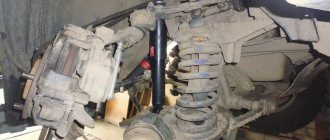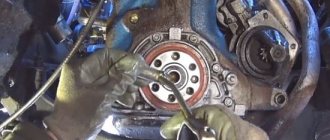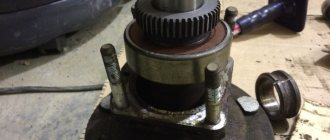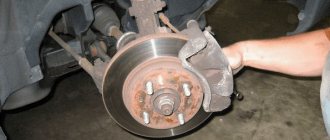Replacing brake components is one of the most common service operations. Replacing brake pads and discs is such a frequent and not so complicated procedure that, in theory, it should be done everywhere without a hitch. But, alas, the human factor sometimes leads to even greater problems with the car. Together with the technical trainer of the Engineering Center SMART Dmitry Protopopov analyzes the most common mistakes made by mechanics.
Poor cleaning of brake system parts before replacement
Before replacing brake pads or discs, it is necessary to disassemble and thoroughly clean all parts of the system. The floating caliper bracket usually has two stainless steel plates on which the pad must slide. The plates must be removed and the dirt and corrosion underneath must be cleaned out, and this must be done so as not to damage the metal on the caliper bracket. In addition, without removing the bracket itself, it will not be possible to properly clean the seat under the plates.
Those who undertake cleaning regularly do it sloppily, using a grinder or a file. As a result, the excess is removed, and the block gets free movement, begins to vibrate during braking, and the vibration is both a squeak and a grinding sound - something that usually irritates customers.
Similar mistakes are made when replacing brake discs. The mating surface of the hub at the point of contact with the brake disc must be cleaned to perfect condition. The cleanliness of this particular surface determines whether there will be runout on the brake disc or not.
High-quality cleaning is necessary for both open and closed caliper guides. But lubrication is required only for closed type guides. It is strictly forbidden to lubricate open type guides.
Main physical characteristics of copper grease and its advantages
The main advantages of the above lubricants include the following parameters:
- high bearing surface;
- excellent hydrophobic properties;
- high adhesion to any materials;
- no drop point;
- low evaporation rate;
- high temperature resistance;
- easy disassembly of devices even after long-term use;
- good corrosion protection;
- ensuring constant tightening force of threaded connections;
- versatility in application;
- excellent capillary properties, allowing the composition to easily penetrate small cracks and holes.
Copper pastes and lubricants:
- reduce vibration and noise;
- withstand high pressure;
- provide electrical conductivity;
- do not contain lead;
- effectively prevent abrasion and jamming of parts.
Incorrect use or complete absence of special lubricants
When replacing pads, it is recommended to use special lubricants, and for each part of the brake system it is necessary to take a specific type of lubricant. For example, for the caliper guides and the piston, a lubricant that is neutral to the rubber boots is needed, for the ends of the brake pads - ceramic, and for that part of the pads that is adjacent to the movable caliper bracket - anti-creaking. The use of universal lubricants, even heat-resistant ones, will cause the brake pads to lose mobility.
Such mistakes are often made due to the total savings of service owners when a barrel of universal lubricant is purchased for all occasions. Mechanics find themselves in a bind and forced to use unsuitable lubricants.
Another common mistake is excessive application of lubricant to the guides, especially to their ends. In the guide well, excess lubrication acts as a hydraulic support that will prevent the guide from moving when the pads are compressed. As a result, the block warps and it jams.
The use of special lubricants when replacing brake system components is an obligatory part of the repair, required by regulations. If a service station offers a service for an additional fee as a separate job, this is a scam. It is better not to contact such a service
How to choose copper grease
You should choose a copper lubricant, first of all, based on what it will be used for. Depending on this, you should choose the consistency of the lubricant:
Copper grease in spray format. It is easy to apply and has low consumption. Most often, this lubricant is used for threaded connections of low responsibility. On cars, elements of the exhaust system and brake mechanism are treated with sprays; the spray can be used to protect spark plug connections;
When choosing a copper lubricant for a car, pay attention to the presence of corrosion inhibitors in the composition. They can extend the life of the lubricant itself, as well as reduce the likelihood of rust forming on the part.
The use of copper grease in the brake system is unacceptable.
A very common misconception is the use of copper grease. In order to prevent sticking, it is mistakenly applied to the contact surface between the hub and the brake disc, as well as to the surface between the brake and wheel disc. Yes, both the wheel and the brake disc will come off easily, but what are the consequences of applying lubricant?
When the copper grease dries, it forms a solid layer of film, which is not completely squeezed out of the contact surface when the wheel is screwed on. With further application, the layer of this film increases, the wheel rim is screwed unevenly. The result is a runout of the brake disc and, as a consequence, a runout of the wheel. In addition, copper grease gets into bolt holes or studs, which should not be lubricated.
Another situation: the use of brute physical force in the event of a disk sticking to the hub. Mechanics often knock it down with a sledgehammer, striking the edge of the disk, which causes cracking and deformation of not only the disk, but also the mating surface of the hub in a place diametrically opposite to the impact, which is invisible at first glance. In the future, even if the disk is replaced, damage to the hub surface will again lead to runout.
In fact, there should be no lubrication at all between the brake disc and the hub, and the disc sticks for the only reason - poorly cleaned contact surfaces, which allow dirt, salt and moisture to get into the gap between them, causing corrosion. And this is again a mistake by the service station mechanics.
Where is copper grease used?
Copper grease is in demand in various industrial fields:
In the automotive industry. Copper grease is used to treat the studs of the exhaust manifold and wheel hubs, the lambda probe, the unoccupied areas of the brake pads and the damping plates that prevent noise. Copper grease can also be applied to spark plugs, various elements of the exhaust and brake systems, and all kinds of threads to protect them from seizing, corrosion, moisture penetration and other defects;
- In the metallurgical industry. Copper lubricants are used to treat low-speed friction units that have to operate in high temperature ranges;
- In the foundry industry. In casting, copper-based lubricant is used to treat mold fasteners;
- In the oil industry. Flange connections, threads, and fasteners are processed in production tools.
The use of a pneumatic impact wrench when tightening parts is prohibited.
Two-thirds of mechanics tighten wheel bolts with an air impact wrench - this is a mistake. Even if after this the mechanic picks up a torque wrench, it is already useless, the bolts are guaranteed to be overtightened. The metal of the wheel rim at the point of contact with the bolt is excessively crushed, the threaded part of the bolt or stud is pulled out, and microcracks appear in the metal. The result is loose pressure on the wheel rim, runout, and wheel separation.
The technical documentation of each automaker indicates the tightening torque of the wheel fasteners, and the task of each mechanic is simply to use this information correctly. The wheel fasteners are tightened using a mechanical tool until the fastener touches the wheel rim, followed by the use of a torque wrench.
A common counterargument: in a car factory, bolted joints are tightened by robots. In fact, this is the cunning of those who, apparently, have a poor understanding of the production process. The robots that work in factories, firstly, are not pneumatic, but hydraulic, with different properties. Secondly, they tighten all connections at the same time, and on perfectly flat surfaces. Thirdly, the tightening torque is checked every work shift, and if there is the slightest deviation, the tool is calibrated or replaced
Other common mistakes
Unpaired replacement of brake discs. Sometimes, due to the stinginess of the client himself, mechanics follow his lead and change the brake disc on only one side. This, of course, cannot be done, since the braking properties on both sides of the car turn out to be different, which can have an unpredictable effect on the behavior of the car. In any case, the service center and the specific mechanic who agreed to do the work will be to blame for this.
A very serious mistake when removing the brake mechanism is hanging the caliper on the brake hoses. If they have the slightest damage, then hanging will lead to further tearing, and during emergency braking, when the pressure in the brake line rises to a significant one hundred atmospheres, to a break in the line, with all the ensuing consequences.
Disposable parts. We will talk about mounting the wheel bearings. This may be a bolted connection or a nut. Bolts, for example, can be tightened with a torque and turned to a certain angle of rotation. Such bolts are definitely replaceable and cannot be reused. The fact is that with any tightening, the bolt shaft stretches, but in critical nodes, for a stronger connection, the angle of tightening is used to achieve maximum extension of the bolt. It is the maximum tension of the bolt that prevents the connected parts from coming apart. Many mechanics do not know this and, for the sake of imaginary savings, use old fasteners. The consequences of such a decision can be disastrous for both the client and the mechanic.
Well, the last one is a non-critical, but still a mistake of service station mechanics: the inability or unwillingness to measure the amount of runout of the brake disc after replacing it or when replacing brake pads. Most service providers focus only on customer complaints, who may not notice anything in everyday use. Therefore, competent technical staff is the key to the success of any service station.
The editors express gratitude to the SMART , a leading independent educational and practical center in the field of auto repair, for their assistance in preparing the material.











